360-Degree-Feedback #6: Technology — Your Ally or Your Adversary?

If you’re an HR professional, chances are you either roll your eyes when you hear the word technology, or you’re a tech enthusiast who believes software can solve everything. The truth lies somewhere in between. Technology can be a powerful enabler for 360-degree feedback — or it can derail the entire process if not chosen and implemented wisely.
Why You Need Software in the First Place
Sure, in theory, you could run a 360-degree feedback process the old-fashioned way: paper surveys, manual Excel work, and printed reports. In practice, it would be a logistical nightmare for everyone involved.
A good software solution can save you dozens of administrative hours and, more importantly, ensure a consistent, professional process. Imagine sending out questionnaires to 50 evaluators, tracking responses, sending reminders, compiling data, and generating individual reports — manually. That could take weeks. The right software does it in a matter of hours.
Key benefits of automation include:
- Automated distribution of personalized survey links
- Real-time tracking of completion rates
- Automatic reminders to non-respondents
- Instant generation of clear, professional reports
- Secure data storage and compliance
Choosing the Right Tool
The HR tech landscape is crowded and often overwhelming. You generally have three main options:
1. Dedicated 360-Degree Feedback Tools
Pros: Advanced features and deep process expertise
Cons: Higher cost and additional system to manage
2. Modules within Your Existing HR System
Pros: Seamless integration, single vendor
Cons: Often lacks depth and advanced capabilities
3. General-Purpose Survey Platforms
Pros: Flexibility, often lower cost
Cons: Not tailored to HR needs, missing key features
Pro Tip:
A specialized tool is often worth the investment. While it may be technically possible to customize your current HRIS, it typically lacks advanced analytics tailored to 360-degree feedback. A dedicated tool can make a significant difference — in both the quality of insights and user experience. Think long term: prioritize the effectiveness of the process over initial cost savings.
Must-Have Features to Look For
Process Management
- Easy configuration of feedback cycles
- Flexible evaluator group management
- Customizable questionnaires
- Multilingual support (if needed)
Security & Anonymity
- Secure data storage
- GDPR compliance
- Built-in anonymity safeguards
- Full audit trail (who did what and when)
Reporting & Analytics
- Auto-generated individual feedback reports
- Customizable report design
- Aggregated insights for HR teams
- Data export for further analysis

ChatGPT fragen
Implementation: Where Things Get Tricky
Choosing the right tool is just the beginning. The real challenge lies in implementation and user adoption. Even the most advanced platform is useless if people don’t use it — or misuse it.
Technical Setup
- Integration with existing systems (if needed)
- User account and permission configuration
- Import of employee and org structure data
- End-to-end testing with sample data
User Preparation
- Administrator training
- User-friendly guides and documentation
- Live tech support during rollout
- Contingency plans for tech hiccups
Pro Tip:
Always run a pilot with a small group before full launch. This will uncover real-world issues that may not show up in lab testing. Be prepared to offer support — not everyone is digitally savvy. Quality technical support can make or break the process.
Advanced Analytics: Where Technology Really Shines
Modern 360° feedback tools go far beyond static reports. Advanced analytics can uncover patterns and insights you might otherwise miss.
Text Comment Analysis
AI can process open-ended responses to identify:
- Common themes and keywords
- Sentiment (positive/negative tone)
- Organization-wide feedback trends
Benchmarking & Normative Data
Some platforms allow you to compare results against external industry benchmarks or internal norms — helping you understand how your leaders stack up.
Predictive Analytics
Top-tier tools can go even further, using 360° data to:
- Predict the risk of key talent attrition
- Identify emerging leadership potential
But a word of caution:
Technology is a tool — not a magic wand. The value of your insights depends heavily on the quality of your data and the robustness of your process. Prepare well, execute consistently, and let technology amplify your efforts — not replace them.




